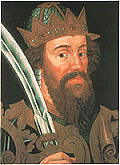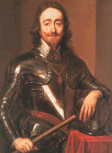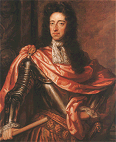

William, The Conqueror, (1066 to 1087) was the illegitimate, and only, son of the Duke of Normandy.
He succeeded to the title in 1035 when his father failed to return from a pilgrimage to Jerusalem.
In 1064, Harold Godwinson, a claimant to the English throne, was forced into swearing an oath
of allegiance to William after becoming shipwrecked off the Normandy coast. Harold was duly elected king
in 1066, much to William's displeasure, and, after obtaining the support of the Pope, the duke mounted
an attack on England. After landing unopposed, William defeated Harold's army at Hastings on 14 October 1066
and claimed the English throne. Hostilities towards William continued by the Anglo-Saxons who had been settling
in England for some time before William came. But William even crushed their rebellions in 1072 for good.

Henry VIII (1509 to 1547) succeeded his father as king at the age of
seventeen. At first he had no enthusiasm for politics or personal rule but external threats to England's security forced
him to pursue a series of costly wars. Decisive victories over the French and the Scots in 1513,
at Tournay and at Flodden Field, helped to secure his kingdom's independence and his domestic popularity.
In order to secure himself a male heir, the king determined to divorce his wife, Catherine
of Aragon, in order to marry Anne Boleyn. As the divorce was not recognized by the pope, Henry
declared himself the supreme head of the church in England.
Anne Boleyn provided Henry with a daughter, later Elizabeth I, but was beheaded for infidelity.
Henry then married Jane Seymour, who died giving birth to his only son, later Edward VI.
This was followed by unhappy marriages to Anne of Cleves, whom he divorced, and Cathrine Howard, who
was also beheaded. Finally, in 1543, he married his sixth wife, Cathrine Parr, who survived him.
All three of his children wore the English crown after his death in 1547.

Mary, Queen of Scots, reigned from 1542 to 1567. Mary Stuart was the daughter
and heir of James V, who died seven days after her birth.
In 1558 she was married to the French dauphin (title of the king of France's eldest son), afterwards Francis II, who
died shortly after his succession to the crown. By marrying Lord Bothwell Mary infuriated many of her
nobles, who forced her to flee Edinburgh.
After being defeated in battle by her nobles, Mary asked her cousin Queen Elizabeth for protection,
but the English queen knew that Mary could still be a rallying point for Catholics and instead
kept her in more or less close captivity.
Finally, accused of being implicated in a plot against Elizabeth's life in late 1586, the tragic Mary
was brought to trial and beheaded after being found guilty of treason. Her son, James VI of Scotland,
succeeded Elizabeth to the throne of England, thus uniting the two crowns, in 1603.
 Elizabeth I (1558 to 1603) was placed after her half-brother, Edward, and her sister Mary,
in the order of succession. At the death of Edward, Elizabeth vigorously supported Mary, but continued throughout
the whole reign to be an object of suspicion and surveillance. When Mary died, Elizabeth was immediately recognized
as queen by Parliament.
Elizabeth I (1558 to 1603) was placed after her half-brother, Edward, and her sister Mary,
in the order of succession. At the death of Edward, Elizabeth vigorously supported Mary, but continued throughout
the whole reign to be an object of suspicion and surveillance. When Mary died, Elizabeth was immediately recognized
as queen by Parliament.
One of her main concerns was the establishment of the reformed religion, introduced by her father. One of her rivals
in this respect was the Scots queen Mary, who was even detained and eventually executed by Elizabeth.
Another rival was Philip of Spain who threatened with his great naval force, the Armada. It was, however, defeated
by the English in 1588 making England the world's greatest seapower.
With Elizabeth's death in 1603 the Tudor dynasty terminated, too.
 Charles I (1625 to 1649) succeeded to the throne in 1625 and was married in the same year to
the sister of the king of France. He had inflexible convictions about the role of the monarchy
in relation to parliament and even reigned without the latter from 1629 to 1640. The new parliament sought to
limit Charles' powers and finally the country was plunged into civil war when the king tried to have
five rivalling members of the House of Commons arrested. Battles between Parliamentarians led by
Oliver Cromwell and the royal army lasted until 1647 when Charles was taken prisoner and brought to
trial. He was beheaded in 1649 and Cromwell became Lord Protector of England. From 1649 to 1660 England was a republic.
Charles I (1625 to 1649) succeeded to the throne in 1625 and was married in the same year to
the sister of the king of France. He had inflexible convictions about the role of the monarchy
in relation to parliament and even reigned without the latter from 1629 to 1640. The new parliament sought to
limit Charles' powers and finally the country was plunged into civil war when the king tried to have
five rivalling members of the House of Commons arrested. Battles between Parliamentarians led by
Oliver Cromwell and the royal army lasted until 1647 when Charles was taken prisoner and brought to
trial. He was beheaded in 1649 and Cromwell became Lord Protector of England. From 1649 to 1660 England was a republic.
 William III (1689 to 1702), prince of Orange and statholder of Holland, was a grandson of Charles I and distinguished himself as a
soldier after successfully repelling French attempts to invade the Netherlands.
William III (1689 to 1702), prince of Orange and statholder of Holland, was a grandson of Charles I and distinguished himself as a
soldier after successfully repelling French attempts to invade the Netherlands.
In 1677 he married Mary, the daughter of the duke of York. She became heir to the throne in 1685 when her father became
James II.
James II was unpopular, however, because of his attempts to accomodate Catholics. William was duly invited by some of England's leading statesmen
to seize the throne from the king in 1688. He landed in England with a large army but met no resistance, and William and Mary were offered the
crown after agreeing to a Declaration of Rights establishing a constitutional monarchy.
In 1689 William defeated a Jacobite rising in Scotland and a year later won a decisive victory over James in
Ireland (Battle of the Boyne).
His queen, Mary, died of smallpox in 1694, and he ruled alone until a fall from his horse led to his death in 1702.
 Victoria (1819 to 1901) was eighteen when she came to the throne in 1837 and immediately
created a most favourable impression by the tact and composure with which she conducted herself.
Victoria (1819 to 1901) was eighteen when she came to the throne in 1837 and immediately
created a most favourable impression by the tact and composure with which she conducted herself.
In 1840 she married Prince Albert of Saxe-Coburg, and the marriage was a very happy one.The British Empire flourished
under her steady rule. Prince Albert also did much to promote Britain's interests and conceived the idea
of the Great Exhibition of 1851. But when he died of typhoid in 1861, Victoria's reign changed
as she largely withdrew from public life.
Only when she grew older did she recover her early popularity and was generally regarded with affection.
Her last years, however, were clouded by the outbreak of the Boer War in South Africa (1899-1902). But Britain still
dominated world trade at the time of Victoria's death.
|




 Elizabeth I (1558 to 1603) was placed after her half-brother, Edward, and her sister Mary,
in the order of succession. At the death of Edward, Elizabeth vigorously supported Mary, but continued throughout
the whole reign to be an object of suspicion and surveillance. When Mary died, Elizabeth was immediately recognized
as queen by Parliament.
Elizabeth I (1558 to 1603) was placed after her half-brother, Edward, and her sister Mary,
in the order of succession. At the death of Edward, Elizabeth vigorously supported Mary, but continued throughout
the whole reign to be an object of suspicion and surveillance. When Mary died, Elizabeth was immediately recognized
as queen by Parliament. Charles I (1625 to 1649) succeeded to the throne in 1625 and was married in the same year to
the sister of the king of France. He had inflexible convictions about the role of the monarchy
in relation to parliament and even reigned without the latter from 1629 to 1640. The new parliament sought to
limit Charles' powers and finally the country was plunged into civil war when the king tried to have
five rivalling members of the House of Commons arrested. Battles between Parliamentarians led by
Oliver Cromwell and the royal army lasted until 1647 when Charles was taken prisoner and brought to
trial. He was beheaded in 1649 and Cromwell became Lord Protector of England. From 1649 to 1660 England was a republic.
Charles I (1625 to 1649) succeeded to the throne in 1625 and was married in the same year to
the sister of the king of France. He had inflexible convictions about the role of the monarchy
in relation to parliament and even reigned without the latter from 1629 to 1640. The new parliament sought to
limit Charles' powers and finally the country was plunged into civil war when the king tried to have
five rivalling members of the House of Commons arrested. Battles between Parliamentarians led by
Oliver Cromwell and the royal army lasted until 1647 when Charles was taken prisoner and brought to
trial. He was beheaded in 1649 and Cromwell became Lord Protector of England. From 1649 to 1660 England was a republic. William III (1689 to 1702), prince of Orange and statholder of Holland, was a grandson of Charles I and distinguished himself as a
soldier after successfully repelling French attempts to invade the Netherlands.
William III (1689 to 1702), prince of Orange and statholder of Holland, was a grandson of Charles I and distinguished himself as a
soldier after successfully repelling French attempts to invade the Netherlands. Victoria (1819 to 1901) was eighteen when she came to the throne in 1837 and immediately
created a most favourable impression by the tact and composure with which she conducted herself.
Victoria (1819 to 1901) was eighteen when she came to the throne in 1837 and immediately
created a most favourable impression by the tact and composure with which she conducted herself.